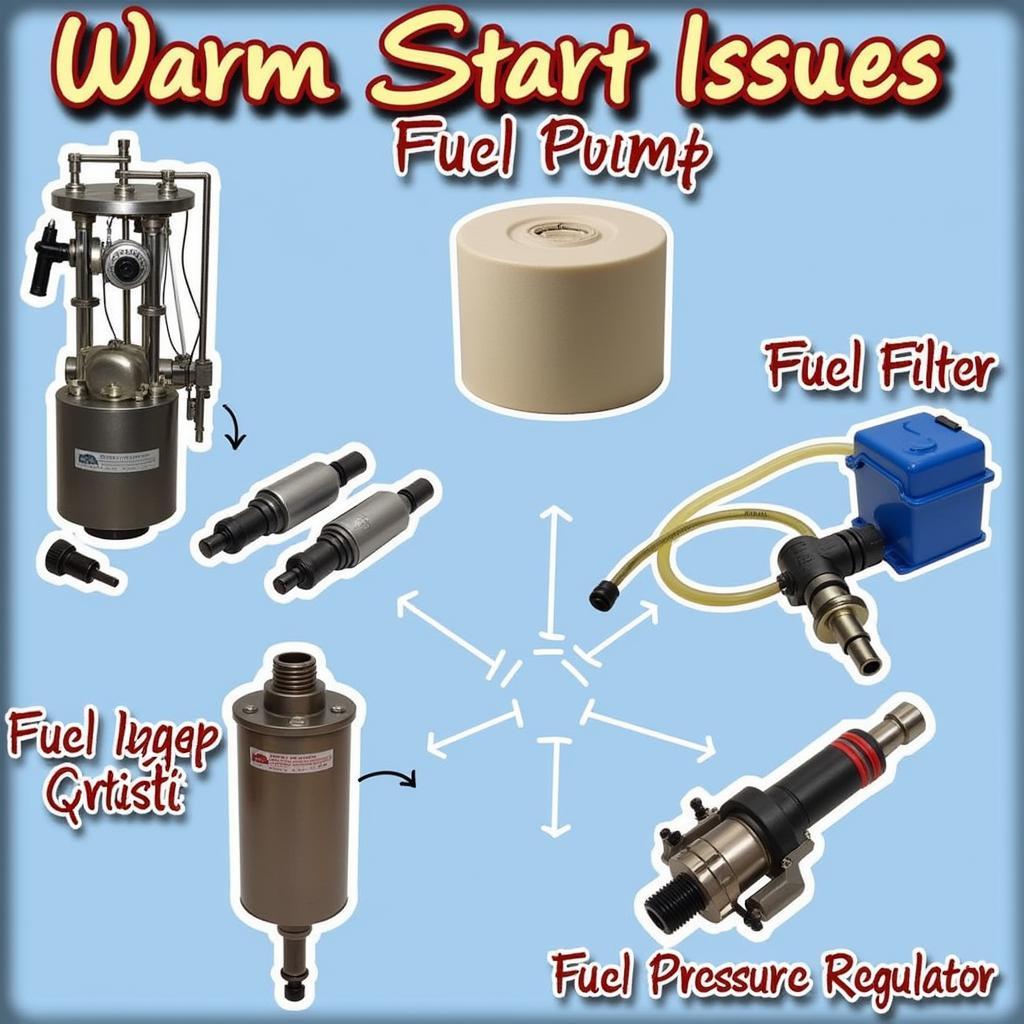A Car Warm Start Problem manifests as difficulty starting your vehicle after it’s been driven and warmed up, then allowed to sit for a short period. Unlike cold start issues, this problem occurs when the engine is still relatively warm. This can be incredibly frustrating and indicate a variety of underlying issues. This article explores the common causes of warm start problems, effective troubleshooting steps, and solutions to get your car running smoothly again.
Have you ever experienced trouble starting your car after a short stop on a warm day? This isn’t uncommon and can stem from issues like fuel system problems or sensor malfunctions. More on this later! For those experiencing car heater matrix problems, this linked article provides helpful insights.
Understanding the Car Warm Start Problem
A warm start problem is distinctly different from a cold start problem. Cold start issues typically arise when the engine is completely cold, often after sitting overnight. These are frequently related to issues with the battery, starter motor, or fuel delivery in cold temperatures. Conversely, a warm start problem occurs when the engine is still somewhat warm, usually after it has been running for a while and then shut off for a period of time – perhaps 15 minutes to an hour. This difference is crucial in diagnosing the issue.
Common Causes of Warm Start Problems
Several factors can contribute to warm start problems. These range from relatively simple fixes to more complex mechanical or electrical issues. Some of the most frequent culprits include:
- Fuel System Issues: Problems with the fuel pump, fuel pressure regulator, or clogged fuel injectors can lead to difficulty starting a warm engine. When the engine is hot, fuel can vaporize more easily, exacerbating existing fuel delivery problems.
- Sensor Malfunctions: A faulty coolant temperature sensor (CTS) can provide incorrect information to the engine control unit (ECU). This can lead to an improper air-fuel mixture, making starting difficult. Similarly, a malfunctioning crankshaft position sensor or camshaft position sensor can also cause warm start problems.
- Evaporation Emissions System (EVAP) Problems: A leaking or malfunctioning EVAP system can introduce fuel vapors into the intake manifold, disrupting the air-fuel mixture and causing hard starting when warm.
- Ignition System Problems: While less common than with cold starts, worn spark plugs, faulty ignition coils, or a failing ignition module can contribute to warm start difficulties.
 Car Warm Start Problem: Fuel System Components
Car Warm Start Problem: Fuel System Components
Troubleshooting Car Warm Start Problems
Diagnosing a warm start problem requires a systematic approach. Here’s a step-by-step guide to help you pinpoint the cause:
- Check for Warning Lights: Note any illuminated warning lights on the dashboard, such as the check engine light, as these can provide valuable clues.
- Listen for Unusual Sounds: Pay attention to any unusual noises when attempting to start the engine, such as clicking, grinding, or whining sounds.
- Inspect the Fuel System: Check for leaks or kinks in the fuel lines and ensure the fuel pump is operating correctly.
- Test the Sensors: Use a diagnostic tool to check the readings from the coolant temperature sensor, crankshaft position sensor, and camshaft position sensor.
- Examine the EVAP System: Inspect the EVAP system for leaks or damage.
- Check the Ignition System: Inspect the spark plugs, ignition coils, and ignition module for wear or damage.
“When dealing with warm start problems, it’s important to check the fuel system first,” advises John Miller, a seasoned automotive technician with over 20 years of experience. “Often, the issue lies within the fuel delivery, especially when the engine is warm.”
 Car Warm Start Problem: Sensor Check Using Diagnostic Tool
Car Warm Start Problem: Sensor Check Using Diagnostic Tool
If you’re facing weather related car problems, be sure to check out this resource for comprehensive advice.
Solutions for Car Warm Start Problems
Once you’ve identified the cause of the warm start problem, you can implement the appropriate solution. This may involve:
- Repairing or Replacing Faulty Components: This could include replacing a faulty fuel pump, fuel pressure regulator, sensor, or component of the EVAP system.
- Cleaning or Replacing Fuel Injectors: Clogged fuel injectors can be cleaned or replaced to restore proper fuel delivery.
- Addressing Ignition System Issues: Replacing worn spark plugs, faulty ignition coils, or a failing ignition module can resolve ignition-related warm start problems.
Winter can bring its own set of challenges. For a comprehensive overview, read about the top problems with cars during the winter.
Conclusion
A car warm start problem can be a perplexing issue, but with a methodical approach to troubleshooting, you can often identify the root cause and implement the appropriate solution. This article has provided valuable insights into the common causes, troubleshooting steps, and potential solutions. Remember, a properly functioning vehicle ensures a safe and enjoyable driving experience. If you continue to experience difficulties, don’t hesitate to contact us at AutoTipPro for expert assistance at +1 (641) 206-8880 or visit our office at 500 N St Mary’s St, San Antonio, TX 78205, United States.
“Regular maintenance and addressing issues promptly can prevent many car warm start problems,” adds Maria Sanchez, an automotive engineer specializing in vehicle diagnostics. “Don’t ignore the warning signs – a little preventative care can go a long way.”
For those dealing with Infiniti radiator problems and occasional bucking, this linked article might be particularly helpful. Also, check out this helpful guide to problems with low resistance car heaters.







Leave a Reply